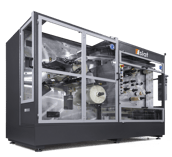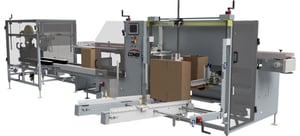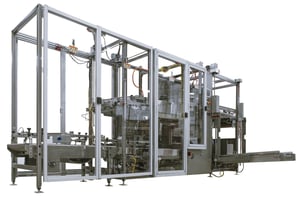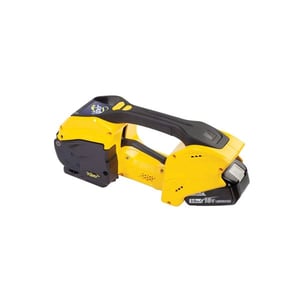When the case erector starts to jam, misfeed or form boxes that fall apart later, the issue probably isn’t the case erector machine.
The most frequent cause of poor packaging equipment performance is the corrugated itself. Here, in no particular order, are five of the most common issues with corrugated that can result in trouble with end-of-line packaging automation.
1. Over-glue in the blanks: When too much adhesive is applied to a joint during production of box blanks, it can get squeezed out of the seam to the inside surfaces of the box. The glue cures while the box blank lies flat—effectively gluing the insides of the box together so it can’t open up in the case erector or tray former.
2. Improper scoring: If flaps aren’t scored precisely or deeply enough, they can fold incorrectly, forcing the box out of square. This can result in taping that doesn’t fully cover the seam, or in reduced strength integrity of the box itself.
3. Crooked glue joints: If the joints aren’t glued perfectly straight during manufacture, the box can open out-of-square in the case erector.
4. Too much recycled content: Recycling paper shortens its structural fibers, resulting in corrugated that’s weaker than an identical product made from virgin stock. That can cause box blanks to jam in the case erector or tray former—especially when running at high speeds. Also, some tapes have trouble adhering to boxes made with too much recycled content—an issue that can often be resolved with different tape rather than a change in corrugated specs.
5. Moisture: Corrugated that misfeeds and jams may have been compromised in transport by exposure to water or high humidity. If it’s a chronic issue, it’s possible that onsite storage of blanks requires improved climate controls.
To prevent and resolve automated box forming problems, work with your corrugated distributor to pinpoint where the issues originate:
- Is the blank designed correctly?
- Do the blanks you’re receiving meet the original material specifications?
- Are the blanks manufactured within the required tolerances?
- Are storage conditions satisfactory?
- Are your tape and glue engineered for use with the type of corrugated being used?
In addition, if a corporate procurement department is in charge of sourcing your corrugated, be sure to communicate the importance of meeting specs precisely. When a packaging line has to make frequent stops or run at slower speeds to avoid jamming, the cost in reduced capacity and shipping delays is likely to exceed any savings from lower-priced corrugated.
Mark Freidly, senior regional sales manager at Combi Packaging Systems, says it’s common to receive service calls on equipment, only to discover that the issue is with the corrugated.
“When we do an installation, we let our customers know that packaging automation puts a premium on the quality of the corrugated they use,” he says. “They need to talk to their corrugated supplier. If boxes are being assembled by hand, the tolerances don’t have to be as tight. But once you put corrugated through a machine, it has to be just right. If your supplier knows you’ve added automation, they’ll know the importance of extra quality control.”
Freidly also points out that the output of a single corrugated production facility can vary from one day to the next depending on multiple variables—including the availability of specified paper stocks and even the weather. When ordering from different manufacturers – as many companies do to minimize supply chain disruptions – the range of variables increases.
“It can come as a surprise that you can order the same box from different places and they don’t all work the same when you run them through the machine,” Freidly says. “We see it all the time. Corrugated can be finicky, and even the best manufacturers see variations from one production run to the next.”
Do you need more productivity from your box-forming processes? Contact Combi Packaging Systems for the best understanding of your options.

.png?width=172&name=End%20of%20Year%20Sale%20Equip%20Drop%20Down%20(172%20x%20157%20px).png)






.png?width=161&name=ProWrap%20(1).png)


